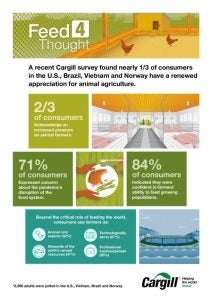A recent Cargill study found a majority of consumers stand ready to rally around farmers in support of their efforts to put food on tables around the globe. Consumer recognition for the challenges and expectations farmers face grew amid the COVID-19 pandemic, as processing and transportation bottlenecks, especially in the protein industry, stretched the global food supply. In the latest Feed4Thought survey, Cargill found nearly one-third of consumers in the U.S., Brazil, Vietnam, and Norway have a renewed appreciation for animal agriculture.
“When consumers experienced bare shelves at grocery stores, they were reminded of the critical role livestock and aquaculture farmers play in global food security,” said David Webster, president of Cargill Animal Nutrition & Health.

Cargill found 71 percent of consumers express concern about the pandemic’s disruption of the food system, and that two in three consumers acknowledge an increased pressure on animal farmers to supply safe, affordable protein since COVID-19’s onset.
These new challenges have not, however, deterred consumers’ faith in farmers: an overwhelming majority of consumers (84 percent) indicated they were generally confident in farmers to meet demand and feed growing populations. More than half of consumers indicate they feel positively toward/appreciative of farmers, with one-third saying that their perceptions have improved as compared to pre-pandemic. This high confidence and increased appreciation toward farmers suggest that COVID-19 may be acting as a catalyst in strengthening the relationship between consumers and farmers.
With this also comes consumers’ growing recognition of farmers’ roles and responsibilities. Beyond the critical role of feeding the world, consumers also see farmers as stewards of the earth’s natural resources (47 percent), animal care experts (42 percent), technologically savvy (21 percent) and professional businesspeople (20 percent).
“On a day-to-day basis, farmers play multiple roles,” Webster said. “They work to keep their animals healthy and free of disease, protect the earth’s resources and manage their operations sustainably, provide employment and run a profitable business.”
The study suggests respondents believe technology can help farmers address the challenges they face. Of those surveyed, 29% would like to see farmers prioritize technology that improves animal health and wellbeing, while 28% would like to see technology that improves overall food safety.
Technology and innovation continue to help farmers overcome challenges.
- Real-time scans in poultry houses use Artificial Intelligence (AI) and machine learning, giving farmers insights to maximize animal comfort, health and improved efficiency.
- Companies like Cainthus are investing in computer vision technology. When farmers have access to real-time data, they can make more informed decisions that can improve nutrition, enhance animal well-being and comfort, and ultimately increase milk component yields.
- The new, portable EWOS SalmoNIR technology from Cargill uses near-infrared spectroscopy to provide salmon farmers with real-time data on fat content, pigment, omega-3 and other important parameters, helping them make better, quicker farm management and nutrition decisions.
The study also found that technology desired by consumers varies across markets. In Vietnam, consumers reported the strongest technology requirement, with 36% of the respondents expecting farmers to be tech-savvy. The U.S., too, may be showing increased connection between farmers and technology, especially among younger generations who were more likely to desire technology that improves animal health and well-being.
Nearly a quarter of younger Americans (Gen Z, ages 18-23) look to source their food from farms using the latest technology, which is significantly higher than older cohorts, especially baby boomers.
“Agriculture has always been a technology industry,” said Webster. “But as consumer support of farmers continues to grow, we see an opportunity to create a dialogue that provides greater visibility into the innovative advancements we’re seeing in agriculture today and highlighting the important role technology will play in the future of our food.”
Become an ag insider with AGDAILY!
We deliver quality over quantity. Sign up here!


